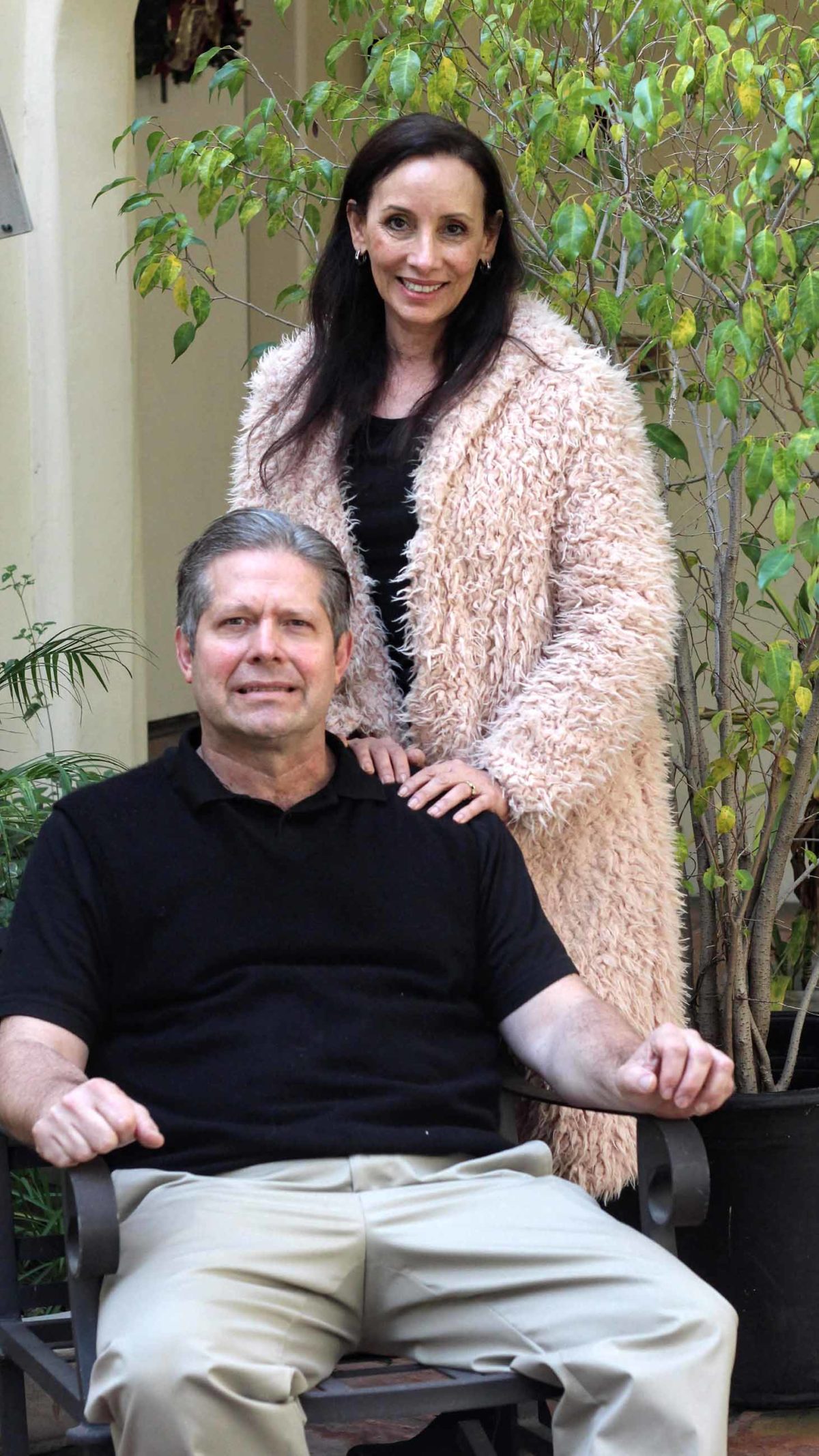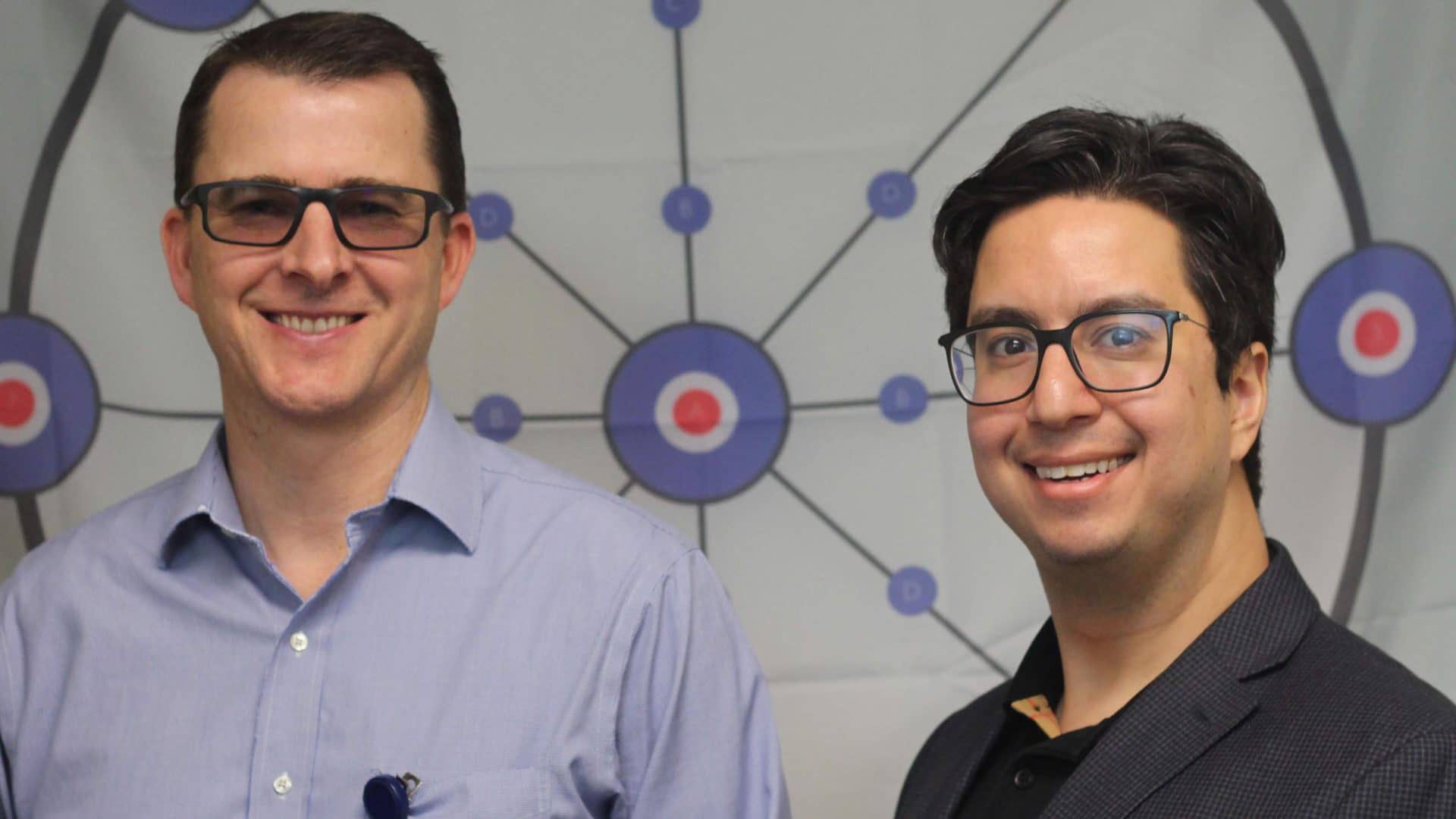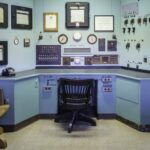For Patients With Memory Loss, Working Towards Better Diagnosis
As he neared his 50s, Anthony Andrews realized that living inside his own head felt different than it used to. The signs were subtle at first. “My wife started noticing that I wasn’t getting through things,” Andrews says. Every so often, he’d experience what he calls “cognitive voids,” where he’d get dizzy and blank out for a few seconds.
Over time, Andrews’ issues became more pronounced. It wasn’t just that he would lose track of things, as if the thought bubble over his head had popped. A dense calm had descended on him like a weighted blanket. “I felt like I was walking through the swamp,” says Andrews, now 54. He had to play internet chess each morning to penetrate the mental murk.

In 2016, Anthony Andrews and his wife Mona were told he likely had CTE, a neurodegenerative disorder caused by repeated head impacts.
Visual: Elizabeth Svoboda
With his wife, Mona, by his side, Andrews went to doctor after doctor racking up psychiatric diagnoses. One told him he had ADHD. Another thought he was depressed, and another said he had bipolar disorder. But the drugs and therapies they prescribed didn’t seem to help. “After a month,” Andrews recalls of these treatments, “I knew it’s not for me.”
After a few rounds of diagnostic hopscotch, Mona found David Merrill, a psychiatrist and brain researcher at the University of California, Los Angeles. Other doctors had diagnosed Andrews based mostly on his symptoms, but Merrill proposed a new approach: using computer software called Neuroreader to measure the volume of Andrews’ brain. The results were a shock: Based on small volume changes, along with his history and cognitive tests, Merrill told Andrews that he likely had chronic traumatic encephalopathy (CTE), a neurodegenerative disorder caused by repeated head impacts. Andrews was stunned. CTE? Like Dave Duerson, Junior Seau, and all those other NFL guys? Sure, he’d played football as a kid, but he’d mostly stopped after high school.
Millions of middle-aged Americans like Andrews now find themselves on the precipice of memory loss. Some played contact sports as kids; others have close relatives with dementia or are battling early senior moments. A number of brain disorders, including CTE, can only be officially diagnosed with an autopsy, so many people live without knowing much about the trajectories their minds are taking.
To help fill these gaps, Merrill and other doctors are using new brain-measuring software, including Neuroreader, along with existing brain scans called MRIs. Together, these tools can detect changes in the size of the brain that relate to certain neurological disorders, which helps guide clinicians to a preliminary diagnosis and treatment plan. While the new volume-based analysis is neither definitive nor foolproof, it provides detail and context that may sharpen a neurologist’s judgment of what’s happening inside the brain. “You get information about whether there’s something that’s changed that you don’t see by eyeballing it,” says Merrill, now director of the Pacific Brain Health Center at the Pacific Neuroscience Institute in Santa Monica, California.
For Andrews, Merrill’s assessment brought both devastation and salvation.
As a kid, Andrews never backed down from a scuffle, on the field or off. From the time he started peewee football at age 12, he hurled himself into opposing players in earnest. “I was a running back, and it was very common for us to use our head as a missile,” Andrews says. He attended high school in a tiny town, so his coaches made him a jack-of-all-trades, starting him on offense, defense, and special teams. From August through November, he had five full-contact practices each week.
Andrews relished the hard-hitting culture. He and his teammates admired the deep nicks in each other’s helmets like badges of honor. Once, when Andrews was running a kickoff back, an opposing defender speared him and he passed out. When Andrews came to, he got up, ran to the wrong sideline, then got back into the lineup. “I felt like I was watching myself play,” Andrews remembers. “I still had a pretty decent game, but I felt like I was floating.”
Yet for decades, Andrews thrived. He graduated from college with a degree in accounting. He excelled in the business world, bought a house in Beverly Hills, and helped build a company with Mona, Executive Financial Enterprises, which does business services outsourcing.
But by the time Andrews first showed up in Merrill’s office, he and Mona were sure something was off. Anthony would be on the phone with Bank of America and lose his train of thought. Or he’d tell a big client he would do something and then never follow up on it. Mona says she wondered whether Anthony had just stopped caring: “Is it him? Is he doing it purposely?”
One of the first things Merrill did was order a traditional MRI, which would show a detailed image of the structures inside Andrews’ brain. Andrews’ previous doctor had ordered an MRI about four years earlier, and Merrill wanted a new scan to see if there had been any changes. Radiologists are trained to evaluate MRIs visually, but there was little on either scan that obviously confirmed anything was wrong. “Until more recently,” Merrill says, “the report would be, ‘There’s no evidence of a brain tumor, a brain bleed, a space-occupying lesion. The brain is intact.’”
To get a clearer picture of what, if anything, was happening in Andrews’ brain, Merrill and his colleague Cyrus Raji, a neuroradiologist at Washington University in St. Louis analyzed both MRIs with Neuroreader. The software, which was cleared by the Food and Drug Administration (FDA) in 2015, measures the volume of more than 40 brain areas down to hundredths of a cubic millimeter. It also compares the volumes to those from hundreds of healthy control subjects. Other software, such as NeuroQuant and FreeSurfer, performs similar analysis. (Raji occasionally consults for Brainreader, the company that makes Neuroreader, to share his scientific expertise.)
The software’s detailed volume measurements reveal brain problems invisible to the naked eye and can provide important clues about a patient’s condition and prognosis. “People with different brain disorders have different atrophy patterns,” says Raji. Analyses of dozens of brains at autopsy have shown that people with mild to moderate CTE often have shrinkage in areas of the brain responsible, in part, for reasoning or basic body functions — including the frontal lobes, the brainstem, and the ventral diencephalon — compared to normal brains. That’s very different, Raji says, from what shows up in Alzheimer’s patients, who get progressive shrinkage in regions like the hippocampus, which governs long-term memory. And patients with memory loss related to poor blood flow display their own distinct neural signature, with gradual volume loss in nearly every brain region.
Andrews’ Neuroreader analysis showed that his frontal lobes, brainstem, and ventral diencephalon were abnormally small, in line with someone with CTE. In particular, his brainstem volume was well below normal for someone his age. But most striking was the distinct pattern of volume loss over time. Andrews’ ventral diencephalon — an area that includes the hypothalamus, which regulates basic bodily functions — had shrunk by about 10 percent in the four years since his first MRI. In the same period, his total gray matter had shrunk by 14 percent, and his frontal lobes by almost 4 percent. Some areas where Andrews’ brain had lost volume are also where damaged clumps of a molecule called tau protein are known to accumulate in diagnosed cases of CTE.
“The abnormalities in the brain system were really what jumped out at me,” Raji says. He thought of the damage documented in CTE journal articles he’d read. “It was the same abnormalities.” At UCLA, Raji quantified the brain volumes of more than 250 memory loss patients, and those with a history of traumatic brain injury show brain atrophy patterns similar to Andrews.
When Andrews learned the results of the doctors’ analysis, he was distraught. But that soon gave way to relief. For a long time, he’d worried he was in the early stages of Alzheimer’s. His scans showed that probably wasn’t the case, since his hippocampus had actually grown larger since it was first measured. And now that he had some idea what might be going on inside his brain, Andrews and his doctors could form a plan to fight it.
Andrews also wondered about his childhood teammates. Might something similar be happening to their brains? And what about the millions of other Americans who’d played contact sports as kids?
Anthony Andrews was shocked when he learned he likely had CTE. Sure, he’d he’d played football as a kid, but he’d mostly stopped after high school.
Most media coverage of CTE has focused on former NFL players. But the disease has recently been diagnosed in people who only played high school sports, which means it might be present in a much larger swath of the population.
In contact sports, when athletes smash their heads, they unwittingly set off a molecular firestorm inside. When two helmets collide, the brains slosh around inside the skulls. That back-and-forth motion wreaks havoc on axons, which are the impossibly long and skinny fibers that project from nerve cells in the brain. The axons stretch like rubber bands, tearing delicate tubes inside that carry important chemicals across the brain. At the same time, tau protein that reinforces the axons breaks away, forming clumps that block key pathways between brain cells. In some people, these tau clumps build and spread over time, causing cell death, brain shrinkage, and progressive dementia.
Definitive CTE diagnosis happens during an autopsy, when a doctor removes the brain, slices it into thin wafers, and stains it with a chemical that binds to the clumps of tau protein, so they show up as distinctive dark patches under a microscope. But this analysis isn’t part of a standard autopsy, so many families never learn what caused their loved ones’ mental decline.
With Andrews’ permission, Raji and Merrill decided to draft a scientific journal article about his case, envisioning that the way they’d evaluated Andrews’ brain could become part of the diagnostic workup for CTE. In the article, Merrill, Raji, and their colleagues clarified the need for studies of other patients to confirm the approach. But “the history, progressive cognitive and mood decline, along with longitudinal brain atrophy, make the possibility of CTE likely,” they wrote. The article appeared in the American Journal of Geriatric Psychiatry in 2016, making Andrews the first living high school football player with suspected CTE to be featured in a medical journal.
Merrill and Raji kept their subject anonymous. But after I contacted Andrews through Merrill, he opted to go public in hopes it might motivate others with memory loss to learn more about their condition. “Anybody in this country right now who has a problem with memory gets an MRI scan. They render an interpretation — that’s the end of it,” Raji says. “Given that these scans are already being done, would we not be in a better position to help patients if we can extract more information from those scans? We should interpret them in a way that adds value to the specific patient’s situation.”
There’s evidence that volumetric software helps clinicians glean valuable new information. In one study of people with a history of traumatic brain injuries, radiologists visually reading MRIs noticed brain atrophy in only 10 percent of subjects. But computerized volume calculations detected atrophy in 50 percent, which suggests this method is better at pinpointing small brain changes.
Neuroreader and its competitors, says Dale Bredesen, a neurologist, neuroscientist, and founding president of the Buck Institute for Research on Aging, highlight many indicators of memory disorders, including CTE and Alzheimer’s. Traditional visual MRI analysis is “almost worthless,” says Bredesen, who uses Neuroreader but has no financial ties to the company. “You have people who disagree with each other — one person will read it as an atrophy, and the other will read it as no atrophy. It’s really difficult, and the volumetrics just make a lot more sense.” Bredesen sees computerized volume analysis as a tool ideally used alongside other diagnostic methods, such as cognitive testing and tracer chemicals that bind to diseased proteins in the brain and light up on a PET scan. (Tests based on this latter approach are available to help diagnose Alzheimer’s, but are still in development for CTE.)
Along with Raji and Bredesen, other providers have started using computer-based volume analysis to help distinguish between brain disorders with similar symptoms. This kind of analysis is now part of the protocol for memory loss patients at major medical centers like UCLA, Washington University, and the University of Pittsburgh. “At the larger academic centers, this is catching on, and even at smaller regional practices,” Raji says. At least two dozen neurologists from the United States and other countries have contacted Raji and asked him to do a computer analysis of their patients’ MRIs.
What shows up in a detailed volumetric analysis might lead Raji to suspect CTE, Alzheimer’s, or age-related dementia. But he’s also able to put people’s minds at ease in a surprising number of cases. Sometimes he sees patients who are worried they have one of these disorders based on a visual MRI analysis, but “when we quantify their brain volumes, they’re completely normal,” he says. And even when the analysis reveals something potentially serious, detecting certain issues can set people on a more promising treatment path. Alcohol-related atrophy may be reversed in some brain regions if patients change their drinking habits, and treating underlying vascular disease can halt brain damage caused by impaired blood flow.
Raji advises neurologists to have memory loss patients get two MRIs at least 12 months apart and do volumetric calculations on each. He thinks the future standard of care might involve getting a baseline brain MRI done when you’re in your 40s or 50s — especially if you have significant risk for dementia. That way, if you start to have memory issues after the baseline MRI, your neurologist can do another MRI and compare the two to quantify any volume loss, just as Raji and Merrill did with Andrews.
Still, computerized volumetric analysis is hardly perfect — it’s just one part of a multi-layered assessment. The technology is also still in its early stages. “Right now, we’re still trying to figure out what are the MRI patterns of CTE,” says Michael Alosco, a professor of neurology at the Boston University CTE Center. Down the line, however, Alosco hopes software like Neuroreader or NeuroQuant will become a standard part of CTE diagnosis. Other options like PET scans, he says, are “not as practical as something like an MRI,” since MRIs are much cheaper and are usually covered by insurance.
Other experts have found the early research unconvincing. When Raji and Merrill’s paper about Andrews first came out, neuropathologist Ann McKee, director of Boston University’s CTE Center, said she was unsure about their preliminary diagnosis. “There are many things that could be causing his symptoms,” she told the health information website Healthline, pointing out that an observation of brain shrinkage is not enough. The only definite way to diagnose CTE and a number of other brain disorders, researchers stress, is still autopsy.
Raji acknowledges the MRI-assisted verdicts are far from absolute, but argues they’re important nonetheless: “No one test is definitive — no one test should be. But you can take different data points and give yourself more confidence in the probability of a certain diagnosis.” Ongoing volumetric analysis of brain scans, he adds, can also give doctors feedback about how well a treatment is staving off brain decline.

Anthony Andrews knows his doctors’ assessment is simply their best-supported theory. Even so, he’s used his results as motivation to stick with the lifestyle changes Merrill recommends. The day I visit him in Beverly Hills, Andrews rattles off his routine: salmon multiple times a week with plenty of chia seeds; gym visits, weight lifting, and push-ups whenever he has the chance (he drops down and gives me 10); and occasional sessions with a cognitive therapist who coaches him through challenging brain games. Just as important is the vigilance to stick to the routine, which is as exhausting as anything else.
Such interventions have shown some scientific promise. One seminal study from 2011 reported that regular exercise increased hippocampal volume by about 2 percent and improved memory in older adults. Omega-3 fatty acids, found in foods like salmon and chia seeds, reportedly boost gray matter volume — something especially important to Andrews, given how much his gray matter shrunk from his first MRI to his second. When Andrews had another MRI in 2017, his gray matter volume was holding steady, and his hippocampus remained a healthy size. That might, in part, be due to his lifestyle changes. With a clearer understanding of Andrews’ deficits, Merrill has also prescribed a drug that has helped other patients with suspected CTE. The drug, called memantine, prevents excessive amounts of a brain chemical called glutamate from damaging brain cells.
Still, nothing is guaranteed. Everything doctors know about CTE indicates it’s a progressive illness, and it’s hard not to think about what happened to people like NFL legend Mike Webster. Before he died of a heart attack, Webster was living out of his truck, one broken window covered with a garbage bag and tape to keep out the cold. But there are some success stories. One example is Gary Plummer, a former San Francisco 49ers linebacker profiled in Sports Illustrated. With a demanding regimen similar to Andrews’, Plummer claims to have recovered some of the cognitive function he lost racking up countless head hits. Recently, he scored better on cognitive tests than he did before he started his regimen. “I don’t think this is a placebo effect,” Robert Stern, director of clinical research at Boston University’s CTE Center, told SI. “If he was on the cusp of cognitive impairment, he may have improved it to the point where he’s functioning a whole lot better.”
So what will the future look like for Andrews? Both he and Mona are cautious. “We’re really lucky that we have the care that we have,” Mona says. Her hope is for Anthony’s condition to remain stable. “If there is a massive decline,” she says, “we’ll just go travel the world.”
Despite the uncertainty ahead, the Andrewses feel fortunate that Anthony has been among the first to get such a specific window onto his brain. Many neurologists around the country don’t yet offer volumetric brain analysis. But as the field progresses, others in Andrews’ position may weigh the prospect of finding out more about what’s happening inside their skulls. Do they want to stay in the dark about their neurological fate, or do they want to learn as much as they can so they can tailor their therapy?
The Andrewses remain firmly in the want-to-know camp. Mona says realizing Anthony likely has CTE saved the couple’s marriage. She no longer wonders if Anthony is missing details or slacking on purpose, since she knows his brain issues can cause these lapses. For his part, Anthony has a new mission: Helping others in the same situation manage as best they can. “If you want to live a productive life,” he says, “you’ve gotta become a student of this thing.”
Elizabeth Svoboda is a freelance writer based in San Jose, California.











Comments are automatically closed one year after article publication. Archived comments are below.
Family member – 73 male retired professor – similar symptoms – did Judo from 14-24 weight lifting UK county level 18/40 then continued low level @ gym 3 x week. Social drinker 18 onwards but now doesn’t tolerate alcohol well at all – now only occasionally has 1 large glass with restaurant meal.
Looking for answers – not easy to find in UK!
better diagnosis without effective treatments or interventions is hardly good news. The practices listed here have not been found to be effective in stopping or reversing these types of neuropathies